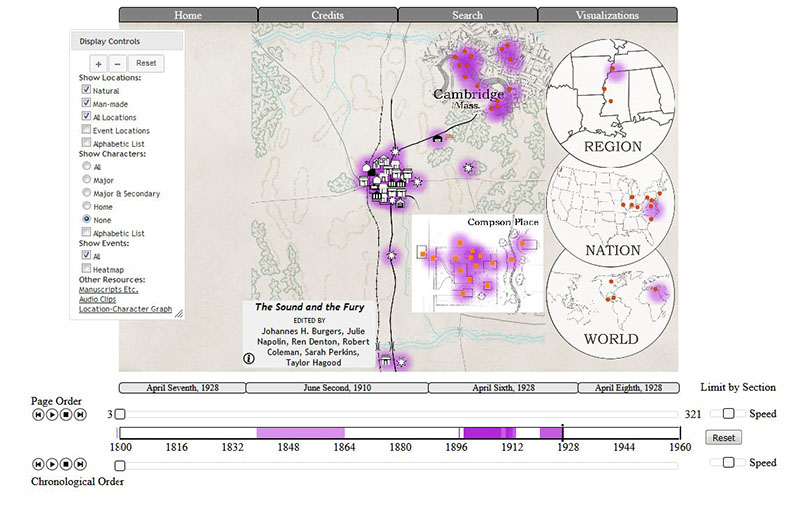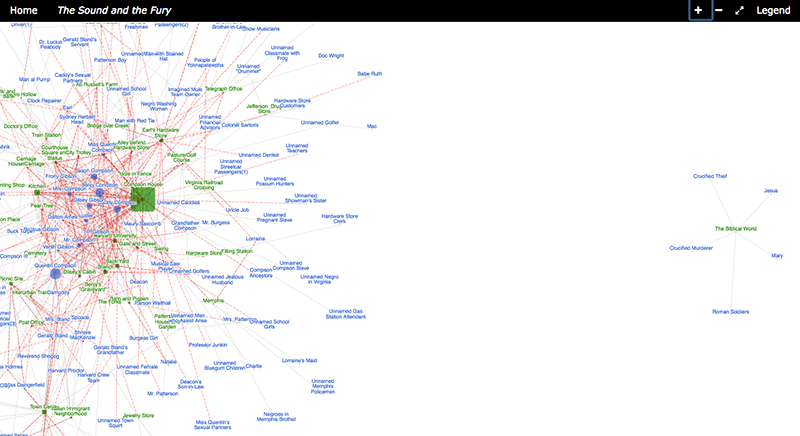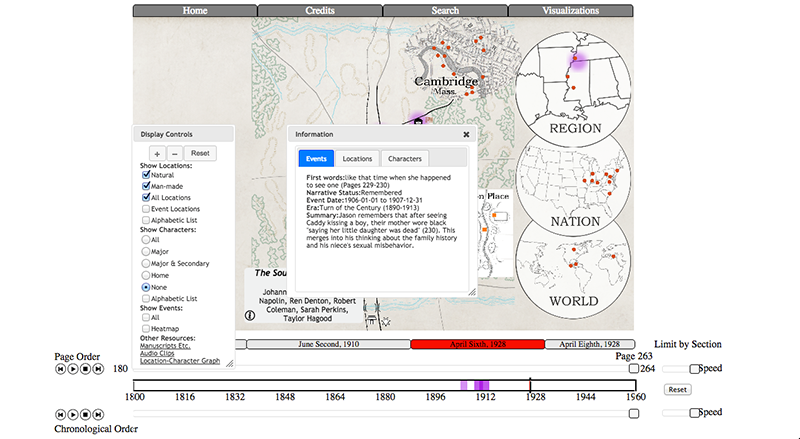Scutio Teaching Faulkner Article
| CLOSE WINDOW |

|
Massachusetts College of Liberal Arts |
|
In the fall of 2016, I was preparing to teach William Faulkner's complex novel, The Sound and the Fury, in my "Faulkner and the Global South" undergraduate seminar. This course explores the reciprocal resonances between the writing of the white southern modernist and the diverse literatures coming out of the Global South, including novels by Ghassan Kanafani (Palestine), Edwidge Danticat (Haiti), and Tierno Monénembo (Guinea). My approach to The Sound and the Fury focuses primarily on space, place, and time, in addition to an emphasis on sexuality, race, class, and gender relations, allowing me to draw connections specifically to Kanafani's All That's Left to You in the next unit. For my undergrads to be able to make cross-cultural associations of this nature, they need to first have a solid understanding of Faulkner's difficult text. Endeavoring to teach the novel in this way, I found Digital Yoknapatawpha (DY) to be a useful resource, and it is clear from their reflections that my students felt the same way. In this essay, I will provide a brief overview of some of the pedagogical issues that arise when teaching a novel like The Sound and the Fury and the different ways in which DY can be used to address them, before ending with some recommendations based on my own classroom experience. One challenge I often face when teaching The Sound and the Fury occurs at the level of plot—aiding my students in parsing out exactly what happens in the novel in what sequence. The novel thwarts our desire for a simple linear narrative, activating us as readers and alerting us to the fact that this will be a different reading experience than that to which we might be accustomed. This is part of what makes the novel so exciting to teach but also what makes it challenging for students to keep up with and fully grasp. These particular difficulties strike students from the start with Benjy's non-linear section told through Faulkner's signature stream-of-consciousness style. Benjy's narrative relies on sensory observations, flashing between memories that he experiences equally as the present. His focus on the senses, loss, and absence, coupled with his lack of the language and thought capacity necessary for reflection and abstraction, present a challenge for first time readers. This difficulty continues in Quentin's section, which Jean-Paul Sartre describes as giving us "access to time without clocks," followed by Jason's more straightforward narrative and the final section told in the third-person and often associated with Dilsey.† While the final section is linear and more clear-cut in narrative style, many students, particularly students of color, report difficulty adjusting to the distance from which Dilsey is portrayed, as well as the use of dialect. The Sound and the Fury section of the Digital Yoknapatawpha site helped to combat many of these issues, particularly around the non-linearity of the early sections. Before my students started the novel, I briefly introduced them to the DY resources, stressing that their work with the site should not take the place of closely reading the novel. This was a concern of mine, which in hindsight held me back from working fully with the site while the students read the novel. I familiarized my students with DY's various visualization tools, such as the location-character graph—an impressive web illustrating the relationships between all the characters (named and unnamed) and locations in the novel. Every character is linked to the locations in which they are either mentioned (depicted by a dotted line), present (a solid line), or both (a dotted line with grey undertones). Each character and location is represented with a different sized node dependent on the frequency of appearances, which led to a fruitful discussion about the ways in which the relationships between the key characters and physical spaces come to the fore. Next, I gave the class an overview of the central page for The Sound and the Fury depicted below. We investigated the spatial and temporal 'maps' broken down by region, nation, and world. Dividing the timeline according the novel's four sections enabled us to track the movements of a character throughout a specific segment of the novel. In addition to exploring the display controls on the left of the page, we also followed the links located there to other resources, such as handwritten manuscript pages of the novel and audio clips of Faulkner's interviews with students at University of Virginia concerning the structure of novel and Caddy's role within it.
After the students finished reading Jason's section, I dedicated more class time towards working with the site. We discussed the location-character graphs in more detail, noting that the Compson House is a spatial focal point of the novel. We speculated about the relationship between the Yoknapatawpha County graph and the smaller, separate biblical story graph and concluded that the biblical story graph is connected to but distinct from the direct experience of the text. Why did Faulkner include connections to the biblical world at all? Which characters is this meaningful for? This led to a discussion of the presence of religion and biblical imagery in the novel more broadly.
(Figure 2: The location-character graph depicts the relationship between the events of the novel in Yoknapatawpha County and the crucifixion story in the biblical world.) Following this conversation, I played through The Sound and the Fury map in its entirety to give the students a visual representation of the relationship between time and space in the novel, and we experimented with the characters feature of the map, which displays major and secondary characters in the locations where they are first introduced. Along with finishing the novel, their homework assignment on this day was to play around with the map and reflect on the following questions: What does this map reveal about the relationship between space and time in the novel? Following our discussion of the Dilsey section during the next class, we had our final workshop with the site. The conversation was more specific. Through the use of the site, the students were able to visualize the ways in which Benjy never physically leaves the Compson place and spends a large portion of the present stuck in the past. According to the map, they concluded that Quentin's section is more complex spatially, since he travels outside of the region, however, he still spends a good deal of time in the present thinking about the past. Unlike Quentin, Jason sticks to the southern region but is more mobile than Benjy. Jason also spends notably less time reflecting on the past. Finally, Dilsey's section is the only one both to involve the world beyond the United States and to spend 100% of time in the present. We compared the fact that Dilsey does not look to the future at all or back to the past to the brothers' outlooks on life and commitments to outmoded southern ideologies, such as honor for white men, a paternalistic relationship towards African Americans, and the desire to control of the sexuality of women. This lead to an insightful discussion about the direction in which Yoknapatawpha County (or its real life counterpart, Lafayette County, Mississippi) was heading in the 1920s and the effects of the transition away from the plantation economy on characters from different subject positions. The students also expressed interest in exploring the search feature of the site, which allows them to investigate characters, events, locations, and even phrases, in relation to their individual paper topics.
In their reflections, my students stated that they found the site's ability to clarify the chronological progression of the events to be its most helpful feature. Some used the chronological order for the map to gain a sense of the actual plot, while others followed the page order on the map but clicked on certain pages to discover the event dates: both effective ways of discerning the order of events. Multiple students reported gaining confidence in their comprehension of the plot, as well as an understanding of the novel's "geographic and chronological scope." One student noted: "The Play by Section feature, in particular, [in]geniously clarifies each time-shift within each section. I enjoyed having Page Order juxtaposed with the chronology of the section because it really puts into perspective how active each character is, not only in time, but in location as well." Almost every student reported that DY helped them to understand the relationship between time and space in the novel, including which characters were stuck in the past and which were able to retool for the present. In addition to an increased understanding of time and space in the novel, DY also aided my students in determining the relationships between the characters. The search feature was instrumental in this respect for its capacity to draw connections between characters across Faulkner's novels. Moreover, in some cases, work with site changed the students' perspectives on an aspect of the novel. For instance, one student noted that after viewing the biblical character graph, she was able to more fully appreciate the religious undertones to the novel, particularly in Dilsey's section. While the location-character graph served to clarify the relationships between the characters, one student would have liked to see the characters' relationships to space more fully represented through the addition of "a 'Compson virtual house' to visualize how certain events took place in relation to each other (i.e. The Branch)." My students were direct about what they found to be the shortcomings of the site. For instance, the students were split on visual presentation of the location-character graph. While some appreciated the clarification of relationships it enabled, others were confused by its overwhelming appearance: "The web map was way too busy and confusing to spend a lot of time with just because no matter how long I looked at it, I would just get a headache." Nevertheless, the location-character graph was the feature that some students credited with illuminating the relationship between the crucifixion story and the latter half of the novel. As the professor for the course, I found the map to be more useful in the classroom setting than the location-character graph from the practical standpoint of what worked better visually on the classroom projection screen. While we could collectively play the events of the map together, the current form of the location-character graph is not as conducive to in-class use, aside from depicting the relationship between Yoknapatawpha County and the biblical world, as previously described. Moreover, some of the pedagogical issues outlined above are outside of the scope of the site, such as Faulkner's decision to write the character of Dilsey from outside of her subjectivity, as demonstrated through the section's opening portrayal of her from a distance—gauzy like a photograph. While to portray the Compsons, Faulkner could draw on his own experiences and intimate connection to this viewpoint and history, he could only represent Dilsey's perspective using the third person mode. It would be interesting to see this difference in representational techniques manifested in a direct way through the site.‡ While issues of race and identity are raised by DY, such as the large number of unnamed black characters in the character-location graph, the complexities and nuances are understandably difficult to capture in maps and graphs. For instance, the race of the characters on the map is denoted by either a black or white figure, which is necessary for the simplicity of such a visual tool, but at the same time, limits the ability to represent racial fluidity or characters of unknown backgrounds. Regardless of this limitation, the use of Digital Yoknapatawpha significantly improved my students' understanding of The Sound and the Fury, and I plan to use it again in the future. However, next time I will not hesitate to introduce the site to students more fully before they begin the novel. My fear that the site would supplant their reading prevented me from using DY as effectively as possible. A number of my students stated in their reflections that the benefits of DY would have been greater had we spent more time working with the site earlier on. Thus, timing seems to be key to maximizing the effect of the site on student comprehension. I'd recommend dedicating class time to the site before the students even crack open the novel, as well as concurrent with their reading of the Benjy and Quentin sections in particular. In addition to playing through the map in class, the use of the extra features, such as the audio clips and images of the original manuscripts went a long way in cultivating interest in both the novel and Faulkner as a writer. One student added that as a writer herself, she drew true pleasure from hearing Faulkner discuss his writing process and intentions for the novel: "it also commits the reader to having a deeper connection with Faulkner, a connection that goes beyond the text. Honestly, how neat is it that we get to glance at his manuscripts? We can see his handwriting and hear his voice, almost as if he were still alive to this day." In my mind, the cultivation of this level of enthusiasm for writers and their literary works is one of the greatest benefits accompanying the burgeoning field of the digital humanities. † Sartre, Jean-Paul. "On The Sound and the Fury: Time in the Work of Faulkner." William Faulkner. The Sound and the Fury, ed. Michael Gorra. (New York: W.W. Norton & Co., 2014: 318) ‡ I discovered after the fact that the character search engine provides an indirect representation of this difference. A search for characters as both "First Person" and "Stream of Consciousness" narrators will reveal the frequency with which Faulkner uses these narrative modes. Narrowing the search to characters categorized as "Black" will make visible Faulkner's refusal to occupy the subjectivities of his black characters. Citing this source: |



